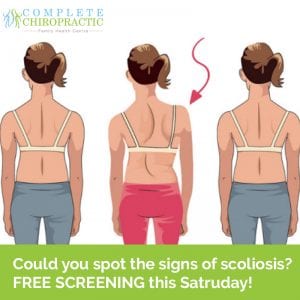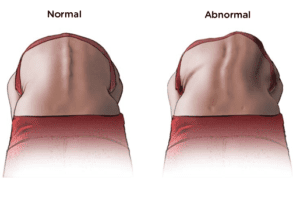Just in case you missed it, this month is Scoliosis awareness month, and this Saturday, our sister clinic, the UK Scoliosis clinic is running a free screening day. Scoliosis can be a serious condition, but the prognosis is excellent when it is spotted early – So what’s scoliosis screening, and why is it important?
What is scoliosis screening?
There are many conditions which we screen for today – breast screening for women is perhaps the most widespread example in the UK, but in many countries, Scoliosis screening for children is almost as widespread. Today, most scoliosis clinicians agree that screening for scoliosis in schools is the right thing to do – for relatively little cost, significant benefits can be obtained for the majority of patients. Screening for scoliosis in schools and other groups, like classes or clubs is quick, easy and cheap. Using our ScoliScreen app, it’s also possible to pre-screen a friend or a family member at home in less than 5 minutes. Early detection of a developing scoliotic curve means it is easier to treat and has a more successful outcome.
It’s for this reason that scoliosis screening is considered as a beneficial stage of treatment amongst the Orthopaedic community, as it is reported in the Consensus Paper which has been published by the Society on Scoliosis Orthopaedic and Rehabilitation Treatment (SOSORT)[1].
For years, clinicians have argued that school screening would be the best way to maximise the benefit of what we now know about scoliosis – Despite this, school screening has still not been routinely performed in the UK for many years. At the UK scoliosis clinic, we strongly support school screening – which is why we have an ongoing outreach program designed to provide exactly this service.
How does scoliosis screening work? 
Scoliosis screening is incredibly simple, not at all invasive and takes less than 15 minutes.
Firstly, a screening involves a quick discussion of your family history as well as any risk factors which may predispose you to develop scoliosis. Since some age groups appear to have a higher prevalence of scoliosis, your vital statistics can also aid in estimating your risk.
The second phase of screening involves what is known as the “Adams forward bending test” – the name is highly descriptive in this instance, the person being screened simply bends forwards, while the screener measures their spine with a Scoliometer (a device not too dissimilar to a spirit level).
Finally, the person being screened is asked to stand upright, while the screener visually checks the symmetry of their shoulder blades and several other key points. Believe it or not, that’s all that’s required to detect, prevent and treat scoliosis.
Using tools such as Scoliscreen it’s possible to run through a basic self-screening routine at home, but for real peace of mind, it’s best to have children screened by a scoliosis professional. There are two main reasons for this.
Firstly, professional screening avoids false positives, which can cause unnecessary distress to parents in particular. At the UK scoliosis clinic, our scoliosis staff have specialist scoliosis screening training which allows us to screen scoliosis with a high degree of accuracy. Essentially, preventing false positives comes down to properly trained staff using appropriate methods.
Secondly, interpreting a screening result effectively and getting the most accurate information relies on really understanding the way scoliosis and the spine work. This might sometimes mean a slight modification to the process – for example, by screening children in sitting position the number of false referrals can be decreased dramatically because the effect of leg length inequality and pelvic obliquity on the spine is eliminated.
Why you should screen ASAP!
The most important reason to screen is the simple fact that scoliosis, like most conditions, is far easier to treat in its early phases, and screening is the best way to spot it at this point. Perhaps a better way of looking at this question is in reverse – given the potential benefit and incredibly low cost involved in screening, is there any reason not to? In their most recently published joint information statement on scoliosis screening, the American Academy of Orthopaedic Surgeons, Scoliosis Research Society, Paediatric Orthopaedic Society of North America and American Academy of Pediatrics all agreed that there does not appear to be any significant medical reason not to screen for scoliosis.[2]
Indeed, today there is significant evidence which shows that the number of scoliosis sufferers eventually requiring surgery can significantly be reduced where non-surgical treatment (such as scoliosis specific exercise, or bracing) is available to a high standard.[3] The most recent research also confirms that this is more than just informed speculation – research does confirm that in areas where screening programs exist, fewer patients ultimately require surgery for scoliosis.[4]
Free Screening on Saturday 15th June
We’ll be running a FREE screening day right here at the clinic, on Saturday 15th June, from 8:30 until 12:00. If you’d like to attend or to bring your children along, please do! Screening takes less than 15 minutes and consists simply of what is described above. It may change your life!
To Guarantee your place, please do book your free ticket via our Eventbrite page Here.
[1] TB Grivas, MH Wade, S Negrini, JP O’Brien, T Maruyama, M Rigo, HR Weiss, T Kotwicki, ES Vasiliadis, LS Neuhaus, T Neuhous, School Screening for Scoliosis. Where are we today? Proposal for a consensus. Scoliosis 2(1) (2007) 17
[2] Information Statement: Screening for idiopathic scoliosis in adolescents. American Academy of Orthopaedic Surgeons (AAOS), Scoliosis Research Society (SRS), Pediatric Orthopaedic Society of North America (POSNA) and American Academy of Pediatrics (AAP), October 1, 2007.
[3] M Rigo, C Reiter, HR, Effect of conservative management on the prevalence of surgery in patients with adolescent idiopathic scoliosis. Pediatr Rehabil 6(3-4) (2003) 209-14.
T Maruyama, T Kitagawa, K Takeshita, K Mochizuki, K Nakamura, Conservative treatment for adolescent idiopathic scoliosis: can it reduce the incidence of surgical treatment? Pediatr Rehabil 6(3-4) (2003) 215-9.
B Lee, The Correct Principles of Treatment of Angular Curvature of the Spine. 1872, Philadelphia, USA.
[4] T.B. Grivas et al. “How to Improve the Effectiveness of School Screening for IS” The Conservative Scoliosis Treatment (2008) p 120

